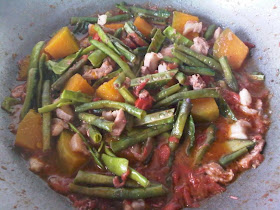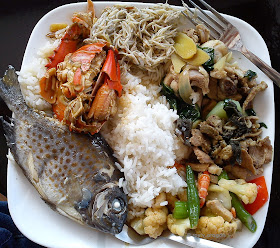 |
| Buridibod a tugi (click photo to enlarge) |
Yet another
buridibod or root vegetable stew, and this time we'll use
tugi (lesser yam,
Dioscorea esculenta Lour.).
Tugi may not be usually used as a
buridibod root ingredient as common as the usual camote or taro or
ube. But it's equally good, I always make one when I chance upon some
tugi in the local market.
Tugi, for some, is only meant to be boiled or
magettaan (cooked in coconut milk) and eaten simply as is, for a carbo snack. But for me, it's an indispensable ingredient for yet another hearty veggie Ilokano dish
 |
| Tugi (click photo to enlarge). |
To go with the tugi for this buridibod, I opted for "native"
pallang (winged beans), "native"
kalunay (spinach, amaranth), and
katuday flower.
 |
| Tugi, pallang, kalunay, katuday (click photo to enlarge).
|
Cook it as you would cook a buridibod, boil the
tugi first until tender, and then put in the greens. Do not overcook the veggies. Here I added in some pre-fried shrimps to enhance flavor and aroma.
 |
| Tugi baradibod (click photo to enlarge).
|
The rest of the
tugi, of course, I boiled it for
merienda. Perfect with black coffee. Or an ice-cold soda, if that's what you're addicted into ;-).
 |
| Boiled tugi (click photo to enlarge).
|
.....
























































